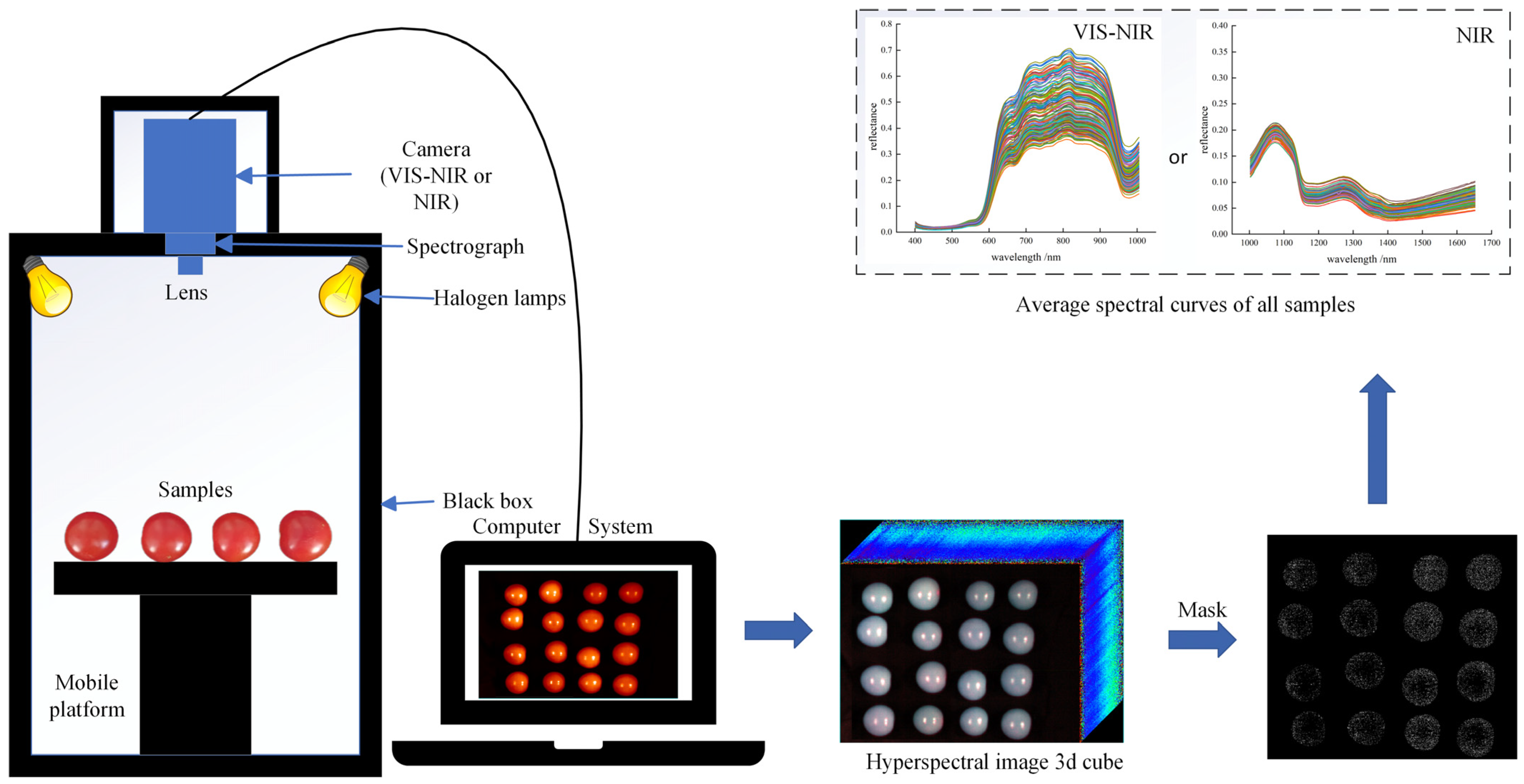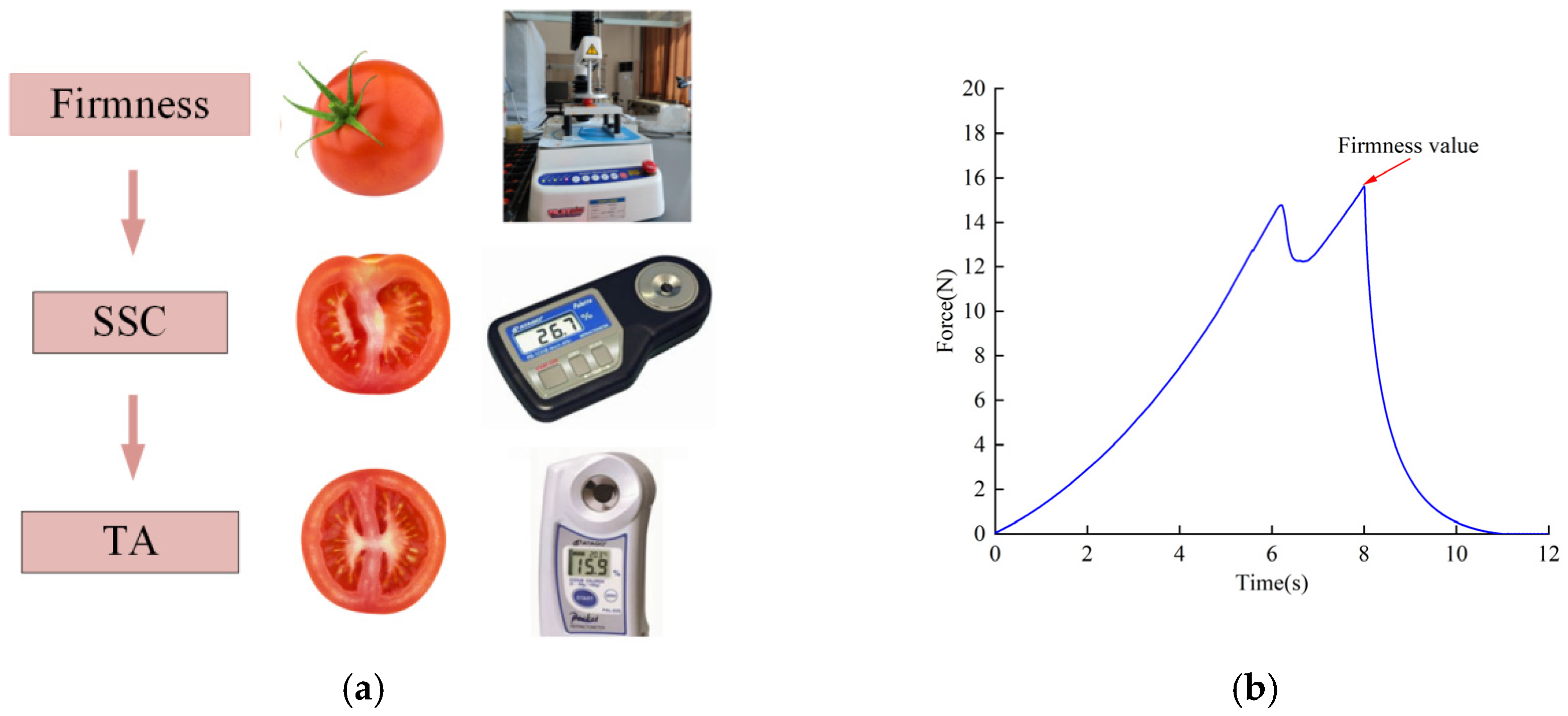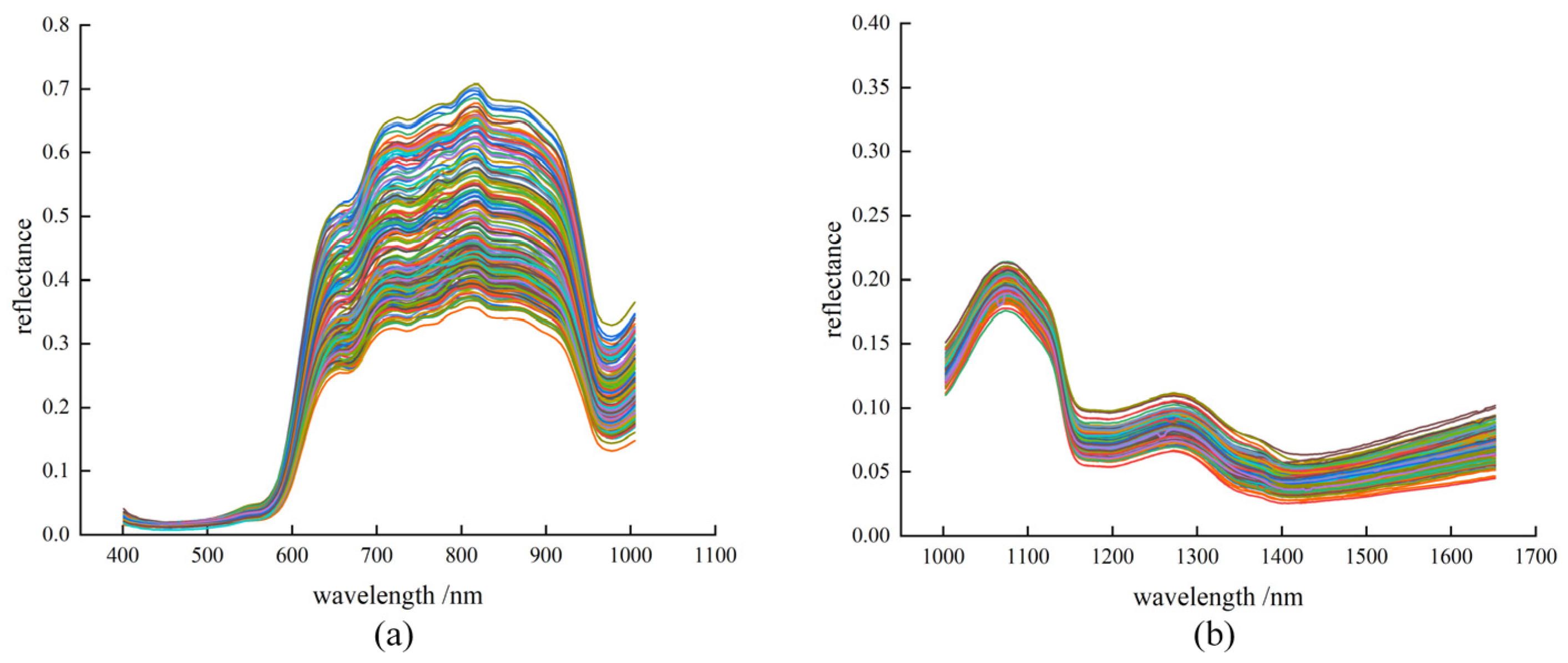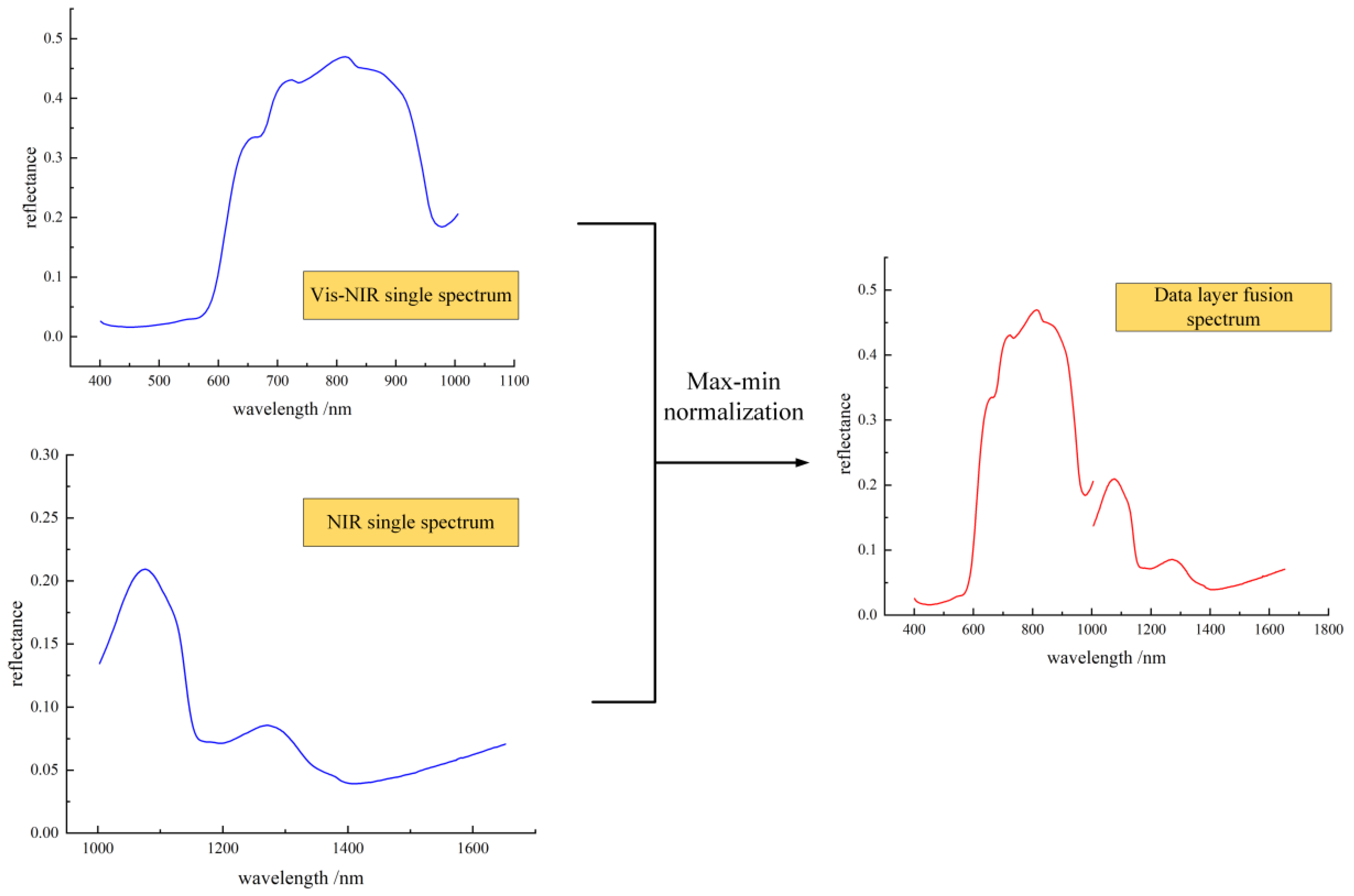Combining Vis-NIR and NIR Spectral Imaging Techniques with Data Fusion for Rapid and Nondestructive Multi-Quality Detection of Cherry Tomatoes
Abstract
:1. Introduction
2. Materials and Methods
2.1. Plant Materials
2.2. Hyperspectral Imaging Acquisition and Preprocessing
2.3. Measurement of Physical and Chemical Indicators
2.4. Modeling Algorithm
2.4.1. Principal Component Regression
2.4.2. Partial Least Squares Regression
2.4.3. Support Vector Regression
2.4.4. Back Propagation Neural Network
2.4.5. Data Fusion
2.5. Model Evaluation
3. Results and Discussion
3.1. Reference Measurements
3.2. Spectral Analysis and Preprocessing
3.3. Data Fusion and Model Construction
3.4. Visual Analysis of Wavelength Contribution of the Optimal Model
4. Conclusions
Author Contributions
Funding
Data Availability Statement
Acknowledgments
Conflicts of Interest
References
- Jiang, Y.; Bian, B.; Wang, X.; Chen, S.; Li, Y.; Sun, Y. Identification of tomato maturity based on multinomial logistic regression with kernel clustering by integrating color moments and physicochemical indices. J. Food Process Eng. 2020, 43, e13504. [Google Scholar] [CrossRef]
- de Brito, A.A.; Campos, F.; Nascimento, A.d.R.; Damiani, C.; da Silva, F.A.; Teixeira, G.H.d.A.; Júnior, L.C.C. Non-destructive determination of color, titratable acidity, and dry matter in intact tomatoes using a portable Vis-NIR spectrometer. J. Food Compos. Anal. 2022, 107, 104288. [Google Scholar] [CrossRef]
- Aykas, D.P.; Borba, K.R.; Rodriguez-Saona, L.E. Non-destructive quality assessment of tomato paste by using portable mid-infrared spectroscopy and multivariate analysis. Foods 2020, 9, 1300. [Google Scholar] [CrossRef] [PubMed]
- Li, L.; Lu, L.M.; Zhao, X.H.; Hu, D.Y.; Tang, T.Y.; Tang, Y.L. Nondestructive detection of tomato quality based on multiregion combination model. J. Food Process Eng. 2022, 45, e14100. [Google Scholar] [CrossRef]
- Feng, L.; Zhang, M.; Adhikari, B.; Guo, Z. Nondestructive detection of postharvest quality of cherry tomatoes using a portable NIR spectrometer and chemometric algorithms. Food Anal. Methods 2019, 12, 914–925. [Google Scholar] [CrossRef]
- Borba, K.R.; Aykas, D.P.; Milani, M.I.; Colnago, L.A.; Ferreira, M.D.; Rodriguez-Saona, L.E. Portable near infrared spectroscopy as a tool for fresh tomato quality control analysis in the field. Appl. Sci. 2021, 11, 3209. [Google Scholar] [CrossRef]
- Yin, L.; Zhou, J.; Chen, D.; Han, T.; Zheng, B.; Younis, A.; Shao, Q. A review of the application of near-infrared spectroscopy to rare traditional Chinese medicine. Spectrochim. Acta Part A Mol. Biomol. Spectrosc. 2019, 221, 117208. [Google Scholar] [CrossRef]
- Yu, X.; Lu, H.; Wu, D. Development of deep learning method for predicting firmness and soluble solid content of postharvest Korla fragrant pear using Vis/NIR hyperspectral reflectance imaging. Postharvest Biol. Technol. 2018, 141, 39–49. [Google Scholar] [CrossRef]
- Shao, Y.; Liu, Y.; Xuan, G.; Wang, Y.; Gao, Z.; Hu, Z.; Han, X.; Gao, C.; Wang, K. Application of hyperspectral imaging for spatial prediction of soluble solid content in sweet potato. RSC Adv. 2020, 10, 33148–33154. [Google Scholar] [CrossRef]
- Li, Y.; Ma, B.; Li, C.; Yu, G. Accurate prediction of soluble solid content in dried Hami jujube using SWIR hyperspectral imaging with comparative analysis of models. Comput. Electron. Agric. 2022, 193, 106655. [Google Scholar] [CrossRef]
- Ye, W.; Yan, T.; Zhang, C.; Duan, L.; Chen, W.; Song, H.; Zhang, Y.; Xu, W.; Gao, P. Detection of Pesticide Residue Level in Grape Using Hyperspectral Imaging with Machine Learning. Foods 2022, 11, 1609. [Google Scholar] [CrossRef] [PubMed]
- Xiang, Y.; Chen, Q.; Su, Z.; Zhang, L.; Chen, Z.; Zhou, G.; Yao, Z.; Xuan, Q.; Cheng, Y. Deep learning and hyperspectral images based tomato soluble solids content and firmness estimation. Front. Plant Sci. 2022, 13, 860656. [Google Scholar] [CrossRef] [PubMed]
- Zhao, M.; Cang, H.; Chen, H.; Zhang, C.; Yan, T.; Zhang, Y.; Gao, P.; Xu, W. Determination of quality and maturity of processing tomatoes using near-infrared hyperspectral imaging with interpretable machine learning methods. LWT 2023, 183, 114861. [Google Scholar] [CrossRef]
- Kiani, S.; Minaei, S.; Ghasemi-Varnamkhasti, M. Fusion of artificial senses as a robust approach to food quality assessment. J. Food Eng. 2016, 171, 230–239. [Google Scholar] [CrossRef]
- Orlandi, G.; Calvini, R.; Foca, G.; Pigani, L.; Simone, G.V.; Ulrici, A. Data fusion of electronic eye and electronic tongue signals to monitor grape ripening. Talanta 2018, 195, 181–189. [Google Scholar] [CrossRef]
- Ding, C.; Wang, D.; Feng, Z.; Li, W.; Cui, D. Integration of vibration and optical techniques for watermelon firmness assessment. Comput. Electron. Agric. 2021, 187, 106307. [Google Scholar] [CrossRef]
- Hu, Y.; Ma, B.; Wang, H.; Zhang, Y.; Li, Y.; Yu, G. Detecting different pesticide residues on Hami melon surface using hyperspectral imaging combined with 1D-CNN and information fusion. Front. Plant Sci. 2023, 14, 1105601. [Google Scholar] [CrossRef]
- Li, X.; Cai, M.; Li, M.; Wei, X.; Liu, Z.; Wang, J.; Jia, K.; Han, Y. Combining Vis-NIR and NIR hyperspectral imaging techniques with a data fusion strategy for the rapid qualitative evaluation of multiple qualities in chicken. Food Control. 2023, 145, 109416. [Google Scholar] [CrossRef]
- Gorry, P.A. General least-squares smoothing and differentiation by the convolution (Savitzky-Golay) method. Anal. Chem. 1990, 62, 570–573. [Google Scholar] [CrossRef]
- Barnes, R.J.; Dhanoa, M.S.; Lister, S.J. Standard normal variate transformation and de-trending of near-infrared diffuse reflectance spectra. Appl. Spectrosc. 1989, 43, 772–777. [Google Scholar] [CrossRef]
- Zhu, H.; Chu, B.; Fan, Y.; Tao, X.; Yin, W.; He, Y. Hyperspectral Imaging for Predicting the Internal Quality of Kiwifruits Based on Variable Selection Algorithms and Chemometric Models. Sci. Rep. 2017, 7, 7845. [Google Scholar] [CrossRef] [PubMed]
- Wang, X.; Xu, L.; Chen, H.; Zou, Z.; Huang, P.; Xin, B. Non-Destructive Detection of pH Value of Kiwifruit Based on Hyperspectral Fluorescence Imaging Technology. Agriculture 2022, 12, 208. [Google Scholar] [CrossRef]
- Lee, A.; Shim, J.; Kim, B.; Lee, H.; Lim, J. Non-destructive prediction of soluble solid contents in Fuji apples using visible near-infrared spectroscopy and various statistical methods. J. Food Eng. 2022, 321, 110945. [Google Scholar] [CrossRef]
- Nicolaï, B.M.; Beullens, K.; Bobelyn, E.; Peirs, A.; Saeys, W.; Theron, K.I.; Lammertyn, J. Nondestructive measurement of fruit and vegetable quality by means of NIR spectroscopy: A review. Postharvest Biol. Technol. 2007, 46, 99–118. [Google Scholar] [CrossRef]
- Thomas, S.; Pillai, G.N.; Pal, K. Prediction of peak ground acceleration using -SVR, ν-SVR and Ls-SVR algorithm. Geomat. Nat. Hazards Risk 2016, 8, 177–193. [Google Scholar] [CrossRef]
- Liu, Y.; Sun, X.; Ouyang, A. Nondestructive measurement of soluble solid content of navel orange fruit by Visible-NIRspectrometric technique with PLSR and PCA-BPNN. Food Sci. Technol. 2010, 43, 602–607. [Google Scholar]
- Tsakiridis, N.L.; Keramaris, K.D.; Theocharis, J.B.; Zalidis, G.C. Simultaneous prediction of soil properties from VNIR-SWIR spectra using a localized multi-channel 1-D convolutional neural network. Geoderma 2020, 367, 114208. [Google Scholar] [CrossRef]









| Sample Set | Number of Samples | SSC (%) | TA (%) | Firmness (N) | ||||||
|---|---|---|---|---|---|---|---|---|---|---|
| Range | Mean | SD | Range | Mean | SD | Range | Mean | SD | ||
| All samples | 200 | 6.10–8.95 | 8.03 | 0.61 | 3.10–3.98 | 3.60 | 0.21 | 14.21–21.97 | 18.51 | 1.70 |
| Calibration set | 150 | 6.25–8.60 | 8.15 | 0.53 | 3.22–3.92 | 3.62 | 0.20 | 14.53–21.46 | 18.66 | 1.64 |
| Prediction set | 50 | 6.10–8.95 | 7.68 | 0.69 | 3.10–3.98 | 3.57 | 0.23 | 14.21–21.97 | 18.07 | 1.81 |
| Spectral Type | Model | SSC (%) | TA (%) | Firmness (N) | |||||||||
|---|---|---|---|---|---|---|---|---|---|---|---|---|---|
| R2C | RMSEC | R2P | RMSEP | R2C | RMSEC | R2P | RMSEP | R2C | RMSEC | R2P | RMSEP | ||
| Vis-NIR (400–1004 nm) | PCR | 0.757 | 0.351 | 0.741 | 0.328 | 0.737 | 0.121 | 0.757 | 0.099 | 0.665 | 0.977 | 0.662 | 0.981 |
| PLSR | 0.763 | 0.348 | 0.749 | 0.299 | 0.713 | 0.124 | 0.718 | 0.101 | 0.679 | 0.953 | 0.677 | 0.94 | |
| SVR | 0.793 | 0.331 | 0.792 | 0.306 | 0.766 | 0.108 | 0.791 | 0.09 | 0.748 | 0.886 | 0.739 | 0.862 | |
| BP | 0.850 | 0.290 | 0.837 | 0.267 | 0.808 | 0.095 | 0.822 | 0.088 | 0.695 | 0.903 | 0.698 | 0.88 | |
| NIR (1002–1652 nm) | PCR | 0.637 | 0.397 | 0.622 | 0.370 | 0.646 | 0.125 | 0.636 | 0.114 | 0.576 | 0.967 | 0.58 | 0.94 |
| PLSR | 0.709 | 0.412 | 0.704 | 0.316 | 0.61 | 0.138 | 0.604 | 0.124 | 0.598 | 0.899 | 0.608 | 0.892 | |
| SVR | 0.745 | 0.316 | 0.736 | 0.309 | 0.693 | 0.140 | 0.704 | 0.118 | 0.696 | 0.863 | 0.692 | 0.861 | |
| BP | 0.805 | 0.305 | 0.792 | 0.289 | 0.77 | 0.119 | 0.758 | 0.105 | 0.617 | 0.886 | 0.621 | 0.88 | |
| Fusion spectrum (400–1652 nm) | PCR | 0.826 | 0.324 | 0.813 | 0.279 | 0.853 | 0.087 | 0.84 | 0.079 | 0.777 | 0.851 | 0.736 | 0.847 |
| PLSR | 0.875 | 0.289 | 0.864 | 0.258 | 0.836 | 0.091 | 0.817 | 0.081 | 0.791 | 0.81 | 0.785 | 0.783 | |
| SVR | 0.924 | 0.287 | 0.917 | 0.234 | 0.895 | 0.082 | 0.874 | 0.077 | 0.882 | 0.663 | 0.862 | 0.647 | |
| BP | 0.957 | 0.260 | 0.938 | 0.193 | 0.922 | 0.078 | 0.919 | 0.069 | 0.825 | 0.728 | 0.816 | 0.709 | |
Disclaimer/Publisher’s Note: The statements, opinions and data contained in all publications are solely those of the individual author(s) and contributor(s) and not of MDPI and/or the editor(s). MDPI and/or the editor(s) disclaim responsibility for any injury to people or property resulting from any ideas, methods, instructions or products referred to in the content. |
© 2023 by the authors. Licensee MDPI, Basel, Switzerland. This article is an open access article distributed under the terms and conditions of the Creative Commons Attribution (CC BY) license (https://creativecommons.org/licenses/by/4.0/).
Share and Cite
Tan, F.; Mo, X.; Ruan, S.; Yan, T.; Xing, P.; Gao, P.; Xu, W.; Ye, W.; Li, Y.; Gao, X.; et al. Combining Vis-NIR and NIR Spectral Imaging Techniques with Data Fusion for Rapid and Nondestructive Multi-Quality Detection of Cherry Tomatoes. Foods 2023, 12, 3621. https://doi.org/10.3390/foods12193621
Tan F, Mo X, Ruan S, Yan T, Xing P, Gao P, Xu W, Ye W, Li Y, Gao X, et al. Combining Vis-NIR and NIR Spectral Imaging Techniques with Data Fusion for Rapid and Nondestructive Multi-Quality Detection of Cherry Tomatoes. Foods. 2023; 12(19):3621. https://doi.org/10.3390/foods12193621
Chicago/Turabian StyleTan, Fei, Xiaoming Mo, Shiwei Ruan, Tianying Yan, Peng Xing, Pan Gao, Wei Xu, Weixin Ye, Yongquan Li, Xiuwen Gao, and et al. 2023. "Combining Vis-NIR and NIR Spectral Imaging Techniques with Data Fusion for Rapid and Nondestructive Multi-Quality Detection of Cherry Tomatoes" Foods 12, no. 19: 3621. https://doi.org/10.3390/foods12193621






